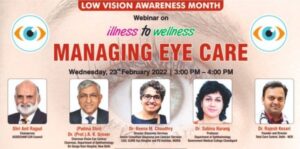COVID has given rise to vision-related problems among children. Therefore, having a balanced diet, along with adequate lighting in the room while studying, correct sitting posture, controlled screen time and regular eye exercises are key points to be kept in mind for maintaining healthy eyes among children.


New Delhi: As part of the ‘Illness to Wellness’ campaign, the Associated Chamber of Commerce and Industry (ASSOCHAM), an apex industry body, hosted a webinar on ‘Managing Eye Care’; this also coincides with the month of February being observed as Low Vision Awareness Month. The main objective behind organizing was to create awareness on how to prevent low vision problems, eye related critical diseases and blindness and maintain overall healthy vision for life.
Throwing light on the rising issue of low vision in India, (Padma Shri) Dr. (Prof) A. K. Grover, Chairman, Vision Eye Centres & Chairman, Department of Ophthalmology, Sir Ganga Ram Hospital said that the process of seeing is a gift of nature and the most structural and functional marvel organ in the body. He added, “The human eye has a resolution of 375-mega pixels. It’s a natural camera with a peripheral vision and it transfers the message to the brain to figure out the colours, movements etc.”
He went on to say that the cataract is the most common cause of blindness in India, and that diabetes is to be blamed for the massive number of damaged eyes. Other causes are corneal opacities, cataract surgical complications (including PCO), diseases of retina and glaucoma. The data shows that even though the rate of blindness has decreased through sustained efforts through the National Program for Control of Blindness (NPCB) have decreased the prevalence of blindness, a whole lot more needs to be done. “In India, one out of every 50 people over the age of 50 is blind,” he said, adding that the government has made ongoing efforts in collaboration with non-government organisations, but primary eye-care in rural areas remains a challenge. To maintain perfect eye vision, a person should consume antioxidants, fruits, and vegetables, eat a balanced diet, and exercise.
Shri Anil Rajput, Chairperson, ASSOCHAM CSR Council, in his welcome address, said, “Good vision contributes to our improved physical abilities, learning and comprehension skills and a better quality of life. Therefore, keeping an eye on your vision health is undoubtedly an essential component of good health and overall wellness.’’
Highlighting the ill effect of the COVID-19 pandemic on the eyes of the children, he said, “The switch to digital learning over the last two years has led to young students staying indoors and spending longer hours in front of their TVs, IPads and mobiles. Therefore, having a balanced diet, along with adequate lighting in the room while studying, correct sitting posture, controlled screen time and regular eye exercises are key points to be kept in mind for maintaining healthy eyes among children.”
Please watch: Computer Vision Syndrome
Diabetes is reaching epidemic proportions in India due to sedentary lifestyle, according to Dr. Subina Narang, Professor, Department of Ophthalmology, Government Medical College, Chandigarh. All diabetics should have regular eye exams every 3-6 months, as directed by an ophthalmologist, in order to diagnose and treat this disease before any visual loss occurs. At the time of their diabetes diagnosis, approximately 27% of patients have retinopathy. She added that a 15-minute break for eye rest can be taken after 45 minutes of reading activity.
Dr. Reena M Choudhry, Director, (Sankara Nethralaya) Glaucoma Services, Senior Consultant Glaucoma and Cataract Services & Chief Operating Officer, ICARE Eye Hospital and PG Institute, Noida, motivated the audience with an eye organ transplant theory and how it works. People can reach out to the nearest national helpline of Eye Bank Association of India after the demise and can donate the eyes that can help two people at once, she added.













